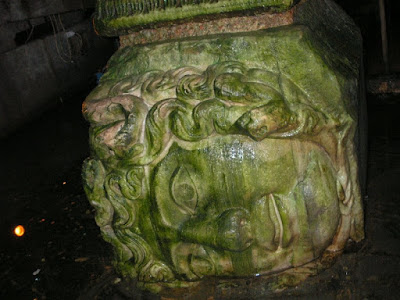
Click to enlarge the Basilica Cistern's forest of columns

After visiting the Blue Mosque, Keelin and I toured the Basilica Cistern. It is in very close proximity to the former Aya Sofya Basilica cum Mosque cum museum, and is the size of a very large church.
According to the handy pamphlet I picked up, this ancient reservoir is "is an underground chamber of 143 by 65 metres, capable of holding 80,000 cubic metres of water." The enormous space is divided by what looks like a forest of "336 marble columns each 9 metres high. The columns are arranged in 12 rows each consisting of 28 columns."
This entire cistern was completely submerged when it was filled with water. And yet every single one of those columns has a carved capital! There are Ionic and Corinthian styles, and a few Doric ones. Emperor Constantine had previously built a basilica and cistern on the same spot, according to some ancient historians. As Constantinople grew, the demand for water grew as well, and Emperor Justinian later enlarged the cistern.
Even though the columns were submerged, and hidden from the public eye, they had ornate capitals, as I mentioned, and some of the columns were even elaborately decorated (see my photo on the right of the "peacock eye" column). The cistern is surrounded by a brick wall 14 feet thick, coated with some sort of waterproof mortar. The water came from the Belgrade Woods—about 12 miles away—through aqueducts (parts of which still survive) built by the Emperor Justinian.

Click to enlarge the Medusa sideways at the bottom of a column
15 Centuries later, they repaired cracks in the wall, and the columns were restored. They reopened the cistern to the public and started charging a 10 YTL admission in 1987.
The bases of two columns at the tail end of the cistern rest on two ginormous sculptures of the head of a Medusa. No one one knows where the heads came from, but some people think they came from an ancient Roman building in Constantinople. Likewise, no one really knows why one of the heads is upside down, and the other tilted to the side. The Medusas are probably for good luck, or to ward off evil (ed's note: which I kind of think of as passive good luck).

click to enlarge Medusa upside down
Finally, at the bottom of the cistern there are about two or three feet of water, filled with well-fed carp. Once again, I am utterly blown away by the scale of the ancient public works and the stunning attention to detail--details no one except maintenance crews and archaeologists would see for 1600 years!

Click to enlarge the carp
---o0o---
No comments:
Post a Comment